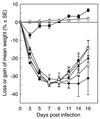Characterization of H5N1 influenza viruses that continue to circulate in geese in southeastern China
- PMID: 11739677
- PMCID: PMC135698
- DOI: 10.1128/jvi.76.1.118-126.2002
Characterization of H5N1 influenza viruses that continue to circulate in geese in southeastern China
Abstract
The H5N1 influenza virus, which killed humans and poultry in 1997, was a reassortant that possibly arose in one type of domestic poultry present in the live-poultry markets of Hong Kong. Given that all the precursors of H5N1/97 are still circulating in poultry in southern China, the reassortment event that generated H5N1 could be repeated. Because A/goose/Guangdong/1/96-like (H5N1; Go/Gd) viruses are the proposed donors of the hemagglutinin gene of the H5N1 virus, we investigated the continued circulation, host range, and transmissibility of Go/Gd-like viruses in poultry. The Go/Gd-like viruses caused weight loss and death in some mice inoculated with high virus doses. Transmission of Go/Gd-like H5N1 viruses to geese by contact with infected geese resulted in infection of all birds but limited signs of overt disease. In contrast, oral inoculation with high doses of Go/Gd-like viruses resulted in the deaths of up to 50% of infected geese. Transmission from infected geese to chickens occurred only by fecal contact, whereas transmission to quail occurred by either aerosol or fecal spread. This difference is probably explained by the higher susceptibility of quail to Go/Gd-like virus. The high degree of susceptibility of quail to Go/Gd (H5N1)-like viruses and the continued circulation of H6N1 and H9N2 viruses in quail support the hypothesis that quail were the host of origin of the H5N1/97 virus. The ease of transmission of Go/Gd (H5N1)-like viruses to land-based birds, especially quail, supports the wisdom of separating aquatic and land-based poultry in the markets in Hong Kong and the need for continued surveillance in the field and live-bird markets in which different types of poultry are in contact with one another.
Figures


References
-
- Alexander, D. J., G. Parsons, and R. J. Manvell. 1986. Experimental assessment of the pathogenicity of eight avian influenza A viruses of H5 subtypes for chickens, turkeys, ducks and quail. Avian Pathol. 15:647–662. - PubMed
-
- Alexander, D. J. 1998. Avian influenza in the eastern hemisphere (excluding the Pacific basin) during 1992–1997, p. 9–13. In D. E. Swayne and R. D. Slemons (ed.), Proceedings of the Fourth International Symposium on Avian Influenza, U.S. Animal Health Association, Tallahassee, Fla.
-
- Alexander, D. J. 2000. A review of avian influenza in different bird species. Vet. Microbiol. 74:3–13. - PubMed
Publication types
MeSH terms
Substances
Associated data
- Actions
- Actions
- Actions
- Actions
- Actions
- Actions
- Actions
- Actions
- Actions
- Actions
- Actions
- Actions
- Actions
- Actions
- Actions
- Actions
Grants and funding
LinkOut - more resources
Full Text Sources
Other Literature Sources
Medical

